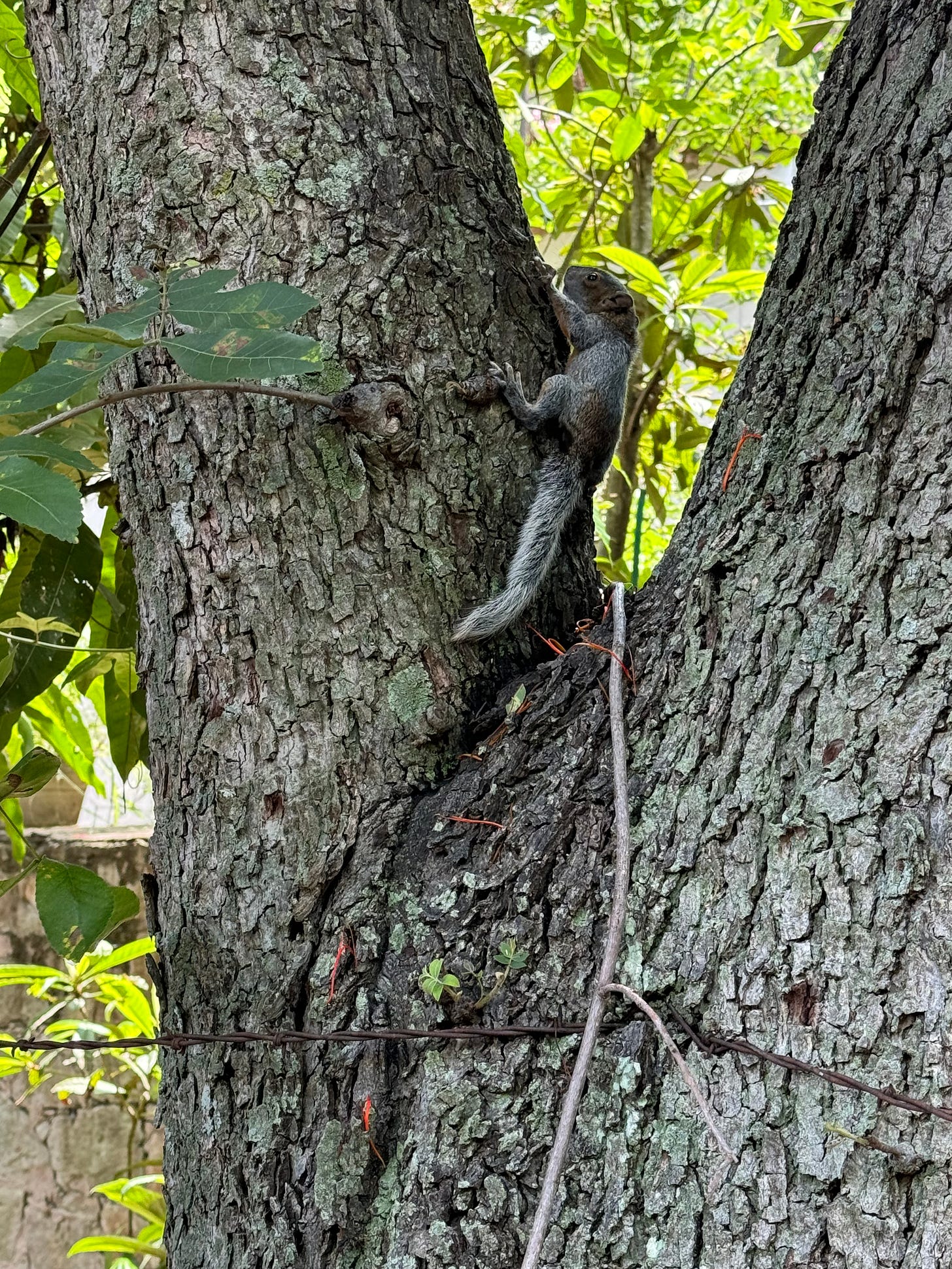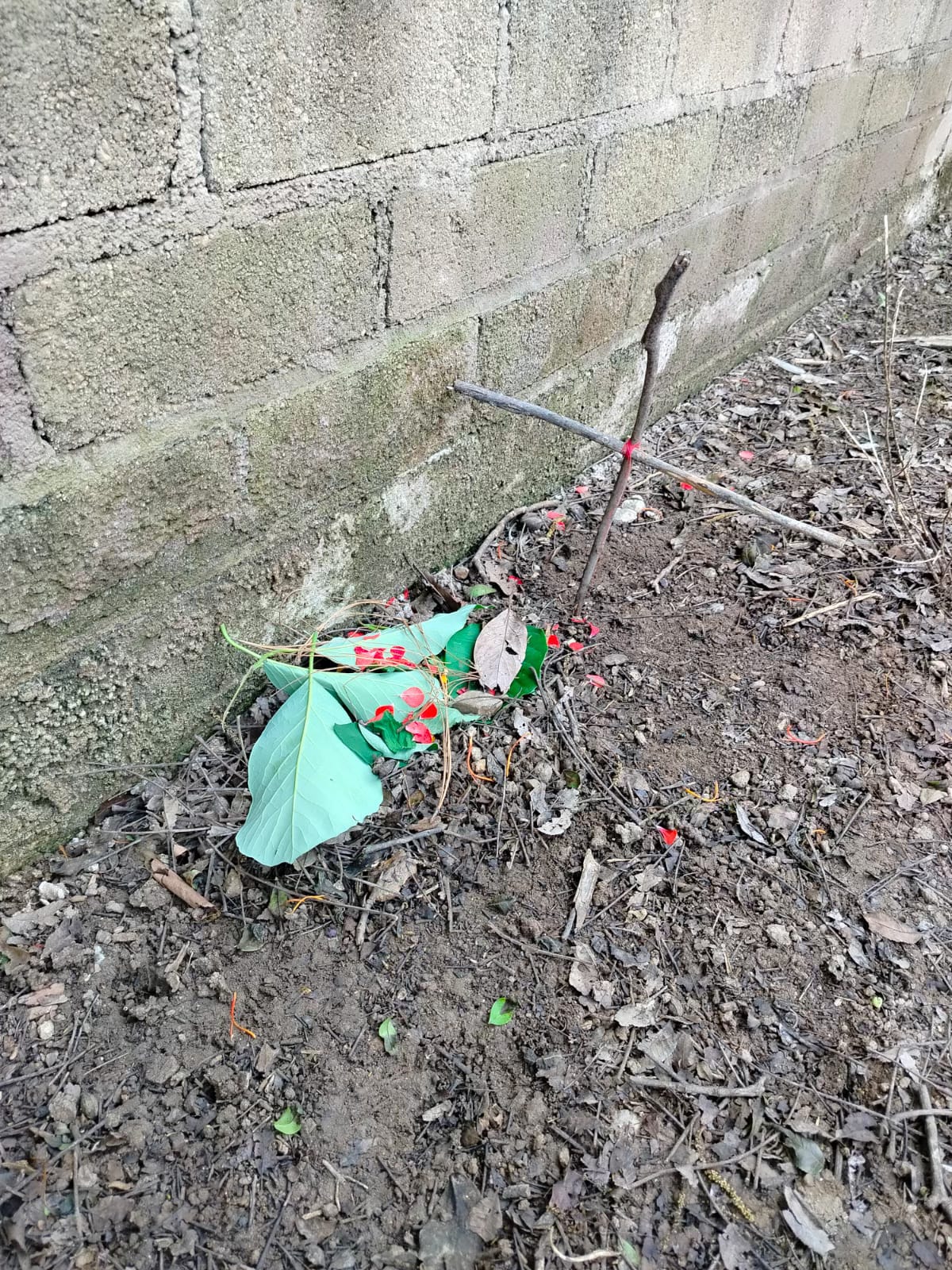“Jake, ven aquí!” I heard Edgar call out. My writing for the day was more or less completed and our friend Jules was visiting for a few days. Ready for a break and wondering what Edgar had found, I stepped away from where I’d been working at our kitchen counter and walked outside to where he stood next to the pool.
Edgar pointed up toward the top of a towering palm tree which sat only a few feet from the edge of the water. “El sonido,” he said, and I realized the squeaking noise I’d been hearing for the past fifteen minutes or so was coming from the spot he was pointing at.
Moving around the center of the tree’s crown was a small, furry shape and Edgar said it was an ardilla—a squirrel. A baby squirrel, in fact.
Having squirrels in our palm trees was another small thing about life in Mexico which, for months, was slightly disjointing. An entire lifetime of seeing squirrels in leafy trees doesn’t prepare you for the moment you encounter them frolicking amongst a bunch of palm fruit or coconuts.
The baby squirrel Edgar had pointed out to me had climbed out of a nest built right in the central cone of the tree. All things considered, it’s a pretty good place for a nest given the extreme height and tight, protected nature of the space the palm fronds grow from. The problem, though, was that Edgar had just trimmed the towering stand of bamboo which sits next to the palm and the trunk of the tree is so hard and slick it’s impossible for a squirrel to climb. There was now no way for a squirrel to either enter or leave the tree and with the mama squirrel nowhere in sight the baby, isolated, had ventured out to explore.
It was immediately clear to us that the squirrel was in trouble. The initial squeaking which attracted Edgar became more frequent and, using my phone camera’s zoom, I could see the squirrel was struggling to find purchase as it moved around. It clung to a clump of disintegrating palm fiber, its body pointing down toward the ground, and as it tried to pull itself back up it was losing strength.
Suddenly, the squirrel fell!
The squirrel tumbled at least 25 feet toward the ground and, miraculously, landed with a splash in the drainage canal at the edge of our pool. Edgar and I raced to where it was struggling in the water and I quickly took off my shirt and tossed it to Edgar so that he wouldn’t have to lift the squirrel out of the pool with his bare hands.
Triumphantly Edgar held up a waterlogged, shellshocked rodent. I’ve always thought that squirrels are essentially just rats with fancy fur coats and seeing a bedraggled squirrel soaking in water reinforced that when they’re not dry and bouncing about they can look fairly disgusting.
Incredibly, the squirrel seemed physically uninjured, but it was also immediately clear we couldn’t simply release it. Not only was it impossible for it to return to its nest in the tree, the shock it was experiencing from landing in the pool made us think it wouldn’t survive the night. And besides, Loo has spent a significant amount of time trying to chase and catch the squirrels on our property and he was eyeing the waterlogged rodent in Edgar’s hands like it was a wriggling breakfast burrito.
We resolved to keep the squirrel in a cardboard box lined with dish towels, which we put into the concrete storage room I had turned into a home gym. Realizing the squirrel needed warmth, the bottom of the box we placed a hot water bottle from Switzerland which we’ve used many a time in New York and Montana to heat our bed on particularly cold nights. I also sent a message to our beloved vet Luciano asking if he had any advice for caring for squirrels. He said no but that he knew someone who did, and he forwarded me a number. The person, whose name is unknown, messaged me in Spanish to say we should give the squirrel cut-up fruit and dried nuts, and that we shouldn’t give it water or milk. It would get more than enough liquid from the fruit alone.
As it dried the squirrel became cuter and cuter and it burrowed under the dish towels and hid its face whenever we checked on it. But if I was careful I could see that, after it was left alone for a bit, it would climb on top of the hot water bottle and splay out, enjoying the ambient warmth.
We kept the squirrel for a whole other day in the box, routinely checking to make sure it was recovering well and eating its food. But as it regained strength I realized my dreams of having a pet squirrel were impossible. When we rescued it from the pool it had already opened its eyes and we realized it was well on its way to adulthood. The moment for me to have a peculiar pet, like some sort of modern-day wizard with a familiar, had passed. This was a wild animal that needed to be returned to the trees.
The vet Luciano recommended we release the squirrel somewhere away from pets and we picked an oak tree with a nice, gentle lean to its trunk and plenty of notched branches. I gently placed the squirrel onto the bark and it quickly scrabbled its way up the tree. It was as good and as gentle a conclusion as we could hope for.
The next day Jules and I left for Mexico City and I returned two days afterward. The next morning Edgar came up to me and asked, “Sabes el cruz en el camino?”
I didn’t understand what Edgar meant. There was a cross in the road?
Edgar held up his phone to show me. Immediately underneath the tree where we had left the squirrel was a wooden crucifix along with a pile of leaves and flower petals. And underneath the leaves, Edgar said, with more pictures as proof, was the ragged corpse of the squirrel.
I was shocked, especially when Edgar told me that in Oaxaca this type of setup, with the cross and the vegetation, is often associated with black folk magic.
There are two possibilities about what might have occurred. The first, which seems the most likely, is that the squirrel was simply unable to adequately care for itself and it either fell out of the tree again or perhaps was attacked by an animal. Someone found the corpse and in an uncharacteristic show of emotion created a small grave for the young creature.
But the other possibility is far more chilling. There’s a local kid, Edgar said, who conceivably might have killed the animal themselves and then dug the shallow grave in which it rested. The kid is young—young enough that I don’t want to say their exact age—and they come from a local home known for being troubled.
I think it’s unlikely, though, that the squirrel was killed by a nascent serial killer. Years of working with kids and teenagers who were often described as “troubled” consistently showed me that it’s easy to blame people who are most often themselves victims. I think a more plausible explanation is that a kid, perhaps the one in question, did find the poor animal’s body and, mimicking the funerary rituals of Oaxaca, decided to show it some grace with a small memorial.
The abrupt appearance of a grave was a sad coda to this story, though. Life in Oaxaca has further encouraged my already existing inclinations toward naturalism and this brush with nature, and with a wild animal, was a little magical. I did wonder if perhaps we could keep the squirrel as a very idiosyncratic pet, even though that seemed both potentially dangerous and also very peculiar. We also knew it was extremely unlikely the squirrel would survive after the fall and we were emotionally prepared for it not to survive the first night or two. But it had seemed so vibrant (and bitey!) that when we went to release it we hoped it would thrive.
Sadly, that wasn’t to be. It was another reminder that, in a place slightly more wild than we’re accustomed to, brushes with both people and animals require new considerations, and a way of resigning ourselves to the unexpected.










Oh pobre ardilla! Que lastima! As we know from jungle living, the creatures in our new 'lands' are not ours to keep but be returned to their natural habitat, but I'm so sorry to hear this one did not make it despite your best efforts Jacob.
Asi es. A different land for sure.